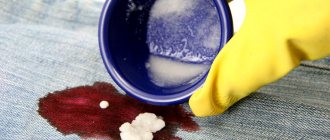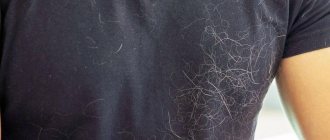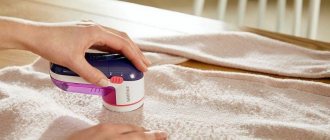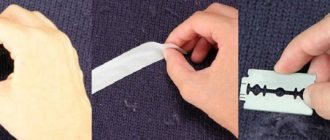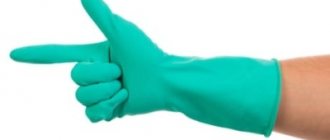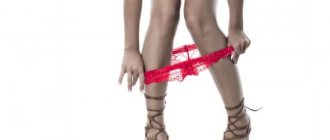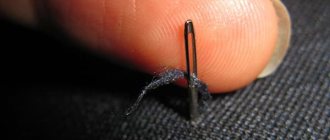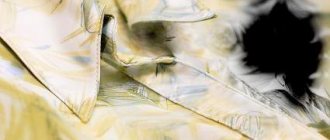Methods
Machine for cleaning products from pellets
Online stores offer a wide selection of machines for eliminating lumps that have appeared. The cost of the devices is affordable, it is no more expensive than a regular clothes brush. Pros: battery operated; The charge is enough to clean several things; compactness of the machine. There are a number of large machines that operate on mains or battery power.
Well-known models from different manufacturers:
- Bomann MC 701 CB (3240)
- Polaris PLR 2022
- Smile MC 3102
- Clatronic MC 3240
Standard equipment of the device: grille with a protective cover; device body equipped with a blade; container for collecting cut lint.
The machine (depending on the model and manufacturer) most often has one or several operating modes (for example, separate adjustment of the nozzle for delicate materials).
Important! Saw clippers are not suitable for fabrics with fluff and high pile. The lint gets wrapped around the screw of the device, making it difficult to operate. And material with large loops clings to the blades, especially if a person works carelessly with the device or presses too hard on the machine.
Pros: efficient, fast and high-quality cutting of pellets and subsequent assembly into a special compartment.
Disadvantages : the procedure for removing pellets when the batteries (battery) are dead becomes slower; Not recommended for high pile materials.
How to care for furniture with matting upholstery
Textiles can be cleaned using dry and wet methods. Both are suitable for matting. Invite the specialists of the company CLEAN EVERYTHING. They will get your upholstery in order quickly and inexpensively. But, if you decide to clean the matting sofa yourself, use the advice of our experts.
Dry cleaning a matting sofa
By home dry cleaning we mean brushing or dusting with a regular vacuum cleaner. Use the special nozzle from the complex. Go over the entire surface of the textiles, inspect the upholstery to see if there are any stains on it. If it is clean, then a simple vacuum cleaner with good power is enough to remove a good half of the accumulated dirt and dust from the textile.
If the furniture has been in use for a long time, it may be time to give the sofa a deep cleaning. You can use:
- Active foam Vanish for textiles and carpets;
- Powder for dry cleaning of upholstered furniture, which will remove dirt from deep within the fibers and eliminate unpleasant odors;
- Products for cleaning car seats;
- Professional dry cleaning of furniture from the company CLEAN EVERYTHING.
Do not use hard brushes to care for the matting. They leave marks on textiles.
Water cleaning of a sofa made of matting
Aqueous solutions of laundry soap and textile shampoo are used to remove stains and deep clean. After treating the fabric with solutions or foam, it must be thoroughly dried, preferably naturally. In the wet season, you will need a hairdryer for this.
Wet cleaning of a sofa with matting upholstery can be:
- Manual (applying foam with a sponge, spraying the finished product from a package with a dispenser) and machine (washing vacuum cleaner);
- Amateur (with your own hands) and professional - with a call from specialists from a specialized company;
- Standard and environmentally friendly - products based on plant-based, environmentally friendly components.
Detergent solutions penetrate too deeply into upholstered furniture and take a long time to dry, which creates conditions for the development of mold and mildew. It is better to use foam, steam from a steam generator, or a moistened microfiber cloth.
Removing stains
By letting the stain dry, you are making your job more difficult. It is easier and more effective to remove it using fresh traces:
- Thoroughly blot any stain with paper towels from top to bottom, without rubbing it on the sofa, without increasing the area of damage;
- If you have Vanish stain remover spray, use it. Follow the manufacturer's instructions on the packaging;
- 10 ml of ammonia per 1 liter of water is a good cleaner for juice and fruit stains. After removing the stain, the remaining solution is carefully removed with a damp cloth;
- Laundry soap will help remove traces of wine, coffee, tea, and dark berries. The foam from it is applied to the stain for a quarter of an hour, then wiped with a damp cloth and dried with a paper towel;
- Wine stains are sprinkled with table salt and then wiped with clean cold water;
- Blot fresh blood with a cotton pad soaked in a hydrogen peroxide solution. Change discs more often so as not to smear a large surface with them;
- Use acetone or an aqueous solution of alcohol (1 tablespoon per 1 liter of water) to remove stains from a felt-tip pen or marker.
Blade or razor as an effective method
A razor can easily handle “coughed” areas, but a sharp blade can damage fabric (especially delicate ones) by cutting through or snagging the delicate material. And when using a dull blade, the pellets are almost impossible to cut off, but it is easy to leave marks and abrasions from the touch of the machine on the material. Recommended for removing pellets from bedding made from a mixture of synthetics and chintz.
Pros: high efficiency, quick results.
Disadvantages: it is easy to spoil the item; the pile has to be collected after cutting.
If things are woolen
If the items are made of natural wool, you need to remove the pellets carefully. Use the razor with caution - not a new one, only on fabric stretched on the fingers (otherwise unpleasant puffs will appear), cut the pellets in a certain direction - from bottom to top. If we use a toothbrush, it must be soft, and we brush it along the wool fibers so as not to spoil our favorite item.
Wool sweaters with pilling look completely untidy
Video: removing pellets from woolen items
If the fabrics are synthetic
On synthetic materials, the pellets are very noticeable; they can be removed with a brush or adhesive tape. It is better not to use a razor here.
Synthetic fabrics also form pills
If the material is cotton
On natural cotton, pellets are formed quite rarely, and if they appear, it is recommended to remove them manually.
Good organic cotton rarely pills
Table: which methods are suitable for which material
| Methods/material | Wool | Synthetics | Knitwear | Cotton | Advantages | Flaws |
| Razor | ✔ |
|
| |||
| Brush | ✔ | ✔ | ✔ |
|
| |
| Manual removal | ✔ |
|
| |||
| Using nail scissors | ✔ |
|
| |||
| Special machine | ✔ | ✔ |
| |||
| Dry cleaning | ✔ | ✔ | ✔ | ✔ | ||
| Scotch tape or roller tape | ✔ | ✔ | ✔ |
|
The most effective methods are a special machine for removing pellets, a clothes brush or dry cleaning.
Method for removing pellets using sandpaper and pumice
Treatment with pumice or sandpaper is based on rubbing the threads that hold the lumps. It’s enough just to stretch the fabric, walk over it with one of the products and just brush off the pellets, they will easily come off.
Important! It should be taken into account that the thinner and more delicate the material, the finer the abrasive is taken. For dense, hard products, sandpaper is recommended, and for knitwear, pumice.
Pros: quick results
Cons: Not recommended for delicate materials.
Clean a sofa at home with your own hands: professional opinion
Our favorite sofas... How many times have we spilled coffee on them through carelessness, getting dirty, leaving stains, crumbs and other contaminants.
What about children and pets? They do not stand on ceremony with upholstered furniture at all and do not even think about how to clean the upholstery later! We won’t bore you with the fact that you should only eat in the kitchen (and many people have a soft corner right next to the dining table!), that animals have no place on the sofa, or recommend buying blankets, protective covers or gray furniture. We will simply tell and show you why you should not try to remove stains on upholstered furniture yourself, since the consequences of self-cleaning can aggravate the situation so much that even professional cleaning will not be able to help you achieve the desired result.
Scotch tape, adhesive roller
Treatment with adhesive tape from the side resembles waxing: we stick the strip with the adhesive side, smooth it and sharply tear it off. It is better to apply where the pili are just beginning to form.
Pros: does not damage the fabric.
Disadvantages: the method does not always cope with lumps; effectiveness depends on the stickiness of the tape.
Another method is a sticky roller for cleaning clothes. Its surface is more sticky than tape.
Pros: copes well with “rolled” areas.
Cons: not recommended for processing thin and delicate materials, high pile.
Reasons why pills form on bed linen
There are several reasons for the formation of saws on bed linen, depending on the manufacturer: the presence of synthetic fiber in the fabric, a violation of the manufacturing process (weak twist of the thread, exceeding the drawing norm, decreased fabric density).
Important! The consumer is advised to choose natural fabrics, follow product care recommendations, and buy underwear from trusted manufacturers.
But not everything depends on the company manufacturing the material. Mistakes in caring for things made by the owner also lead to their destruction. This is washing satin, cotton in too hot water; refusal of air conditioner, which helps maintain the elasticity of the product; ironing dry bed linen. In addition, too frequent washing and mechanical friction against a person during restless sleep also leads to the material rolling up.
On what bedding materials do pills appear?
Lumps appear on fabrics that contain synthetics. The base material is wound onto such a thread, and during use the fabric simply fluffs up and pellets appear. More susceptible to rolling: woolen products, acrylic, knitwear, polyamide, fleece, polyester.
Attention! How to recognize fabric that is likely to have pilling? The labeling indicates a high content of synthetic fibers, the material is loose, the threads are long, and the pile is high. Natural materials (cotton, silk, linen) are less likely to cough.
Another life-saving measure
You can save furniture with olive oil
Buy olive oil and apply it to the scratches. Cover these areas with a cotton cloth and wait until the oil is absorbed. You will need to cover the structure with a cloth and use a lukewarm iron. The device should be kept on the fabric for no more than ten seconds.
There is one caveat to this method of saving a sofa from cat scratches: you can’t just take the iron and place it on the fabric. This will ruin the leather upholstery of your furniture. You should move the device in a circular motion over the fabric until the oil is completely absorbed.
Following the rules of delicate laundry washing as a way to prevent lumps
Why does delicate washing reduce the likelihood of pilling? The mode is based on reducing the spin force of the laundry, and washing occurs with an increase in the volume of water in the drum, which reduces friction of the material. Delicate washing takes place at a temperature of 40 degrees , which reduces the likelihood of fabric shedding. There is no drying option in the washing machine.
Some models do not have the name “delicate wash”, it is replaced by the synonym “hand wash” .
What materials are washed this way? Washing in “delicate conditions” is ideal for artificial fabrics (polyester, elastane, viscose) and natural ones (silk, wool).
Important! Before washing, you should carefully study the label of the bed linen, which states the composition, washing and ironing mode.
For this mode, choose liquid detergents , which are easier to wash out of the fabric.



